Table Of Contents
Do you currently drive leads from Facebook ads?
What if there’s a powerful way to double or even triple the number of leads you generate from Facebook advertising platform. Here are real-life proofs:
Nissan South Africa increased leads by 27X and generated car sales through Facebook Lead Ads.
Here’s an exciting success story:
Real Madrid, the legendary Spanish Football team generated 2.4 million leads and decreased cost per lead by 70% with Facebook Lead Ads.
Unfortunately, many B2B companies don’t use social media for lead generation. Those that make efforts only use LinkedIn and ignore other channels.
Maybe they feel that the decision makers, startup founders, and CEOs who can sanction their products are rarely on social media.
That couldn’t be further from the truth.
You need to consider social media platforms to acquire B2B leads for your business. — especially Facebook.
See, Facebook is so big that no matter who you want to capture as leads, you can effectively target them. If you like, your business can advertise to the 2.32 billion monthly active users on Facebook in the next 48 hours.
If you’re a small business, for example, even a few thousand leads and sales per month will make you smile. Isn’t it?

Facebook advertising platform offers so many options. One of such options is Facebook Lead Ads. And that’s exactly what we’ll discuss in this post.
Facebook Lead Ads is both a unique and genius idea. Initially, businesses advertise on different advertising channels and attract potential leads to their landing pages.
Then these visitors will read your landing page copy before they decide to fill out your form or buy your product.
Consequently, this can discourage the prospect from taking the required action. They’re just tired after going through all of the steps.
The good news is that Facebook lead ads allow you to capture leads for your B2B business without users having to leave Facebook.
What are Facebook Lead Ads?
Facebook lead ads are paid ads that allow advertisers to capture leads on Facebook without having to direct Facebook users to an external landing page. Here’s an example:

With lead ads, Facebook eliminated 2 of the biggest barriers to generating leads on social media which are:
- Users leaving social media to your landing page.
- The need to fill out a form outside Facebook.
Now, a process that could take a minute using the traditional lead generation format has been reduced to a few seconds by Facebook lead ads.
It’s a win-win-win situation (if there’s anything like that) for Facebook, the advertiser, and the user.
As a B2B marketer, you can give a simple offer on your ad copy and have users release their personal information before they can claim your offer. You’ll find that that are many details you can require from your potential leads.
Whatever pieces of information you need to follow up with your leads, Facebook allows you to have them in your lead form. For your B2B business, your prospect’s name and email address might be insufficient.
You may also need their work phone number to reach them through a call to explain how your service or product will be of benefits to their business. And the pro here is that your leads don’t need to go through the stress of filling in these details.
Facebook does that. They only have to click submit. Easy.
How to Create Facebook Lead Ads
To create a lead ad, you have to go through a process that’s slightly different from creating other forms of ads. But don’t worry, we’ll go through the process in a moment.
To create your lead ad, navigate to the Facebook Business Manager. Click on the 3 bars at the top left corner of your page and then click on “Ads manager.”

On the next page, click on the “+ Create” button to create your Facebook ad. This is the process for creating an ad including a lead ad.
First of all, you’ll have to create your campaign. Here, you’ll supply details like campaign name, campaign objective, buying type, ad set name, ad name, and others.

For your campaign buying type, you have to pick between “Auction” or “Reach and Frequency.” For auction, your bid is to reach your audience at the lowest price possible. However, you’ll pay a fixed amount to reach your audience when you select reach and frequency.
To create your Facebook lead ads, you’ll create a distinction with your campaign objective. In your campaign objective, navigate to the “Consideration” stage and select “Lead generation.”
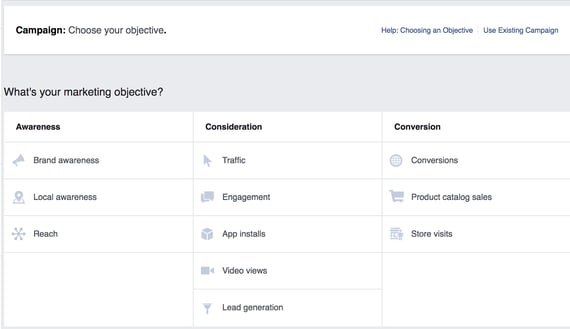
The next step is to select an existing lead generation form or create a new one. For this guide, we’ll be going with the option of creating a new one.
When you select this option, you can enter your campaign name. Ensure you use a unique name you can recognize later on. You can also select the option of creating a split test if you want to test ad sets.

After this, fill in other information like your ad set and ad name. Then click on “Save to Draft.”
One of the most important parts of advertising on Facebook is the cost. You want to capture leads at the lowest cost possible.
To do this, you can set a limit for your campaign on the amount to be spent during this campaign.
Another option is to switch on the budget optimization feature.
This allocates your campaign budget based on your bid strategy and delivery optimization choices. You have to know that you can’t switch budget optimization off once you activate it.

With budget optimization, Facebook allocates more of your funds to the best-performing ads to ensure that your funds can be better utilized. When you’re through with your settings at the campaign level, the next part to edit is your ad set.

Select “Ad Set” at the right sidebar. After doing this, you can select the Facebook page you’ll use for your ads. Then you can either set a daily or lifetime budget.
You can also set the schedule which will include both the start date and time and end date and time.

Now, you’ll have to select the audience for your ad. If you already have a custom audience you’ve used in previous campaigns, you can include them here.
You can include people from a particular custom audience or exclude them. Another option is to create a new custom audience or a lookalike audience.

The next step is to fill in other details like location, age, gender, language, and other details. As you include your targeting details, you’ll see the potential reach your ad can have.
You’ll also see the estimated daily results like the reach and the number of leads you can capture in a day.
As you increase your targeting options, your potential reach becomes lower.
You can also target people based on demographics, interests, or behaviors. When you have your detailed buyer persona, then you should have some information about your lead.
If you’re targeting marketing managers, what are some of their possible interests or behaviors they exhibit? Having this information means you can target your ideal audience effectively.

When you’re through with your targeting options, click on “Save this audience.” You can then select your preferred placement for your ad. You have to select between the 2 options “Automatic placements” or “Edit placements.”
With automatic placements, Facebook will show your ads at places on the website where your ad will perform best. However, if your ads tend to perform better at some locations based on your experience, you can select “Edit placements.”
For instance, if your ads have performed best in the news feed in the past, then you may select this placement.

After this, you can now set your optimization and delivery options. You can select the lowest cost or target cost option for your bid strategy.
If you’re selecting the lowest cost option, you can also select a bid cap to set a limit in how much you can spend.
You can also select between standard delivery and accelerated delivery.
Standard delivery would ensure your budget is spent throughout your schedule while accelerated delivery would spend your budget as quickly as possible to get you the results you need.
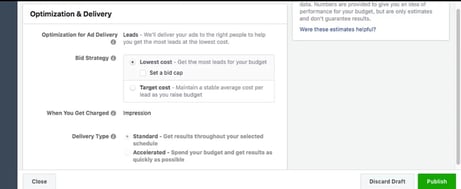
When you’re through with your ad set, you can now create your ad. Click on “Ad” at your right sidebar.
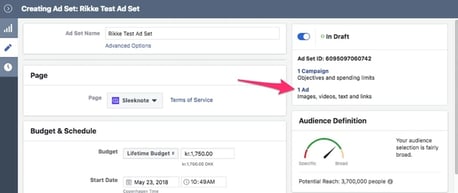
After this, you have to select the format you want your ad to be. You have 4 options which are:
- Carousel
- Single Image
- Single Video
- Slideshow

For Facebook ads, you have to note that the image or video occupies the largest part of your ad. You must use an image or video that is likely to attract your potential lead to a click.
You can select your image from your computer or use a free stock image.
However, for B2B businesses, you should avoid using a stock image as this might look unprofessional to your audience.
After all, you don’t want to tell people to invest thousands of dollars in your business when you can’t even make a professional image.

After this, you can write your ad text, display link, headline, and news feed link description. You should also select your call to action.

You can then choose a lead form or create a new one.
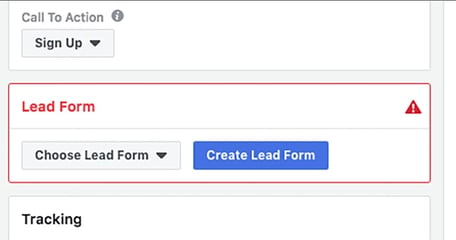
Click on “Create Lead Form” and then select “New Form.” Click on “Next” to continue.

You’ll have to select between “More Volume” or “Higher Intent” for your form type. More volume makes it easier to capture more leads.
The higher intent option will show a review where potential leads can confirm their information before submitting it. This is advisable for a B2B company.

It usually leads to better quality leads. It’s also more costly. If you select the “Higher Intent” option, a review screen option will be added to the lead form.

Below your form type, you can write your introduction which includes a headline, image, and a layout. You can also switch it off.

After this, you can select the information you want your lead to fill in the form. Email and full name are already selected but you can select any piece of information you need from the many options.

You can also add custom questions that relate to your potential lead and how your product can help their business. As you add your questions, you’ll see the changes in your form preview.

You can also add a context card. This provides more details about your ad offer. You can also use this to increase your leads quality.

Your context card has headline text, benefit texts, button texts, and image pulled from your ad.
The context card is optional and you can decide to remove it from your ad. Click on “Skip this step” to exclude the context card from your ad.

Due to how important privacy is for big tech companies, you need to add a privacy policy before you can display your ad. You need to add a link text and a link URL for your privacy policy page. On this page, you’ll explain how you’re going to use details you collect from Facebook.

If you’ve selected higher intent for your form type, you can check to see if it’s intact. Below that, you can see your thank you screen.
This is the page your leads will see after releasing their details.
You can add a link to this page through which leads can visit your website to get more details about your business. You can also add a UTM parameter to your website link so that you can track the number of visitors through the Facebook ad.

When you’re through setting up your ad, you can click on the finish button.

You can check through all your ad details to confirm their accuracy. After doing this, click on the “Publish” button and your ad will go live.

Facebook Lead Ads Examples
One of the best ways to understand the concept of Facebook lead ads for B2B businesses is to see how other B2B businesses are using the platform.
Below are some examples you can learn from:
Facebook Blueprint
Well, what better example than Facebook using its own platform to advertise an offer to other businesses. Look at the sponsored post below:

You can see that this is a service targeted at eCommerce businesses. However, the offer here is to sign up for a webinar to gain the benefit. When you click on “Sign Up” which is the call to action button, it displays this page:

On the page, you can see that apart from the full name, other details required are work email, company name, and job title. These are details that a B2C company doesn’t need from its leads. But it’s relevant to a B2B company.
When you click on “Submit,” it brings you to the thank you page.
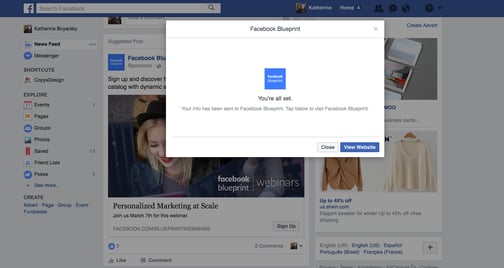
On the page, there’s a “View website” button through which you can visit the website. The text on the page even encourages a lead to check out the website.
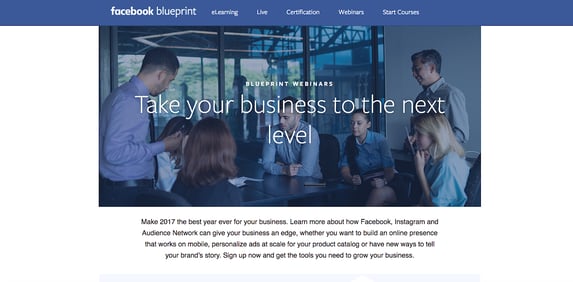
If you click on the button, you’ll be transferred to the website where you can get more details about the webinar.
WordStream
One of the main issues marketers face is increasing their click-through rates. So a guide on how to improve click-through rates will attract a marketer’s attention.
WordStream used a video ad to promote the guide with the call to action “Download.”

When you click on the call to action button, you’ll see a long form. Even though the form is long, the potential lead won’t have to do the work as Facebook fills in the details.

When you click on “Submit,” you’ll see the thank you page and a “Get Your Download” button to get your guide.

Facebook Lead Ads Best Practices
Facebook lead ads still need you to pay attention to some practices that will convince users to click on your ad and become leads. The reality is that no matter what you do, some users will still scroll past your ad.
But these best practices can help you increase the number of leads you’ll capture through your ad.
1. Provide compelling benefits
Capturing a B2B lead can be more difficult than a B2C lead. This is because B2B products usually cost more and could have more devastating effects if it doesn’t work out.
Because of this, a business’ decision maker needs you to convince them before they can even consider your business. Therefore, your lead ad must contain a benefit that a potential lead would like to have in their business.
For a B2B business, you’ll need a lead magnet that provides an immediate benefit to your lead. Some common lead magnets you can use to attract a B2B lead are:
-
Free consultation
-
Whitepapers
-
Ebooks
-
Tools
-
Worksheet
-
Industry reports
Having an immediate benefit for your lead will help to convince them of releasing their personal details.
2. Ask for the most important pieces of information only
On your traditional landing pages, having too many form fields might discourage a potential lead. This may not be a problem as Facebook pre-populate the form fields with a user’s information.
Nevertheless, you shouldn’t ask for too many details. This can make your potential lead uncomfortable and get cold feet.
Even if there are details you may need later, you can always ask once your lead has developed trust in you.
For a B2B business, you might need details like company name and work telephone in addition to details like name and email address.
You don’t need more than these for the purpose of capturing your leads.
3. Target the right audience
If you’re targeting employees that have no input in their company’s decision making, then you’re wasting your ad budget.
One of the most important questions to ask is: who can make the decision for a business to use my product?
When you answer this question effectively, you can use the information to target these decision makers.
For different B2B products, there’ll be different employees who can make the decision to use those products.
For instance, the choice of email marketing software may be left to a marketing manager. Whereas, the decision to purchase some products is made by the CEO.
Apart from targeting the right job description, you must also target the right location.
4. Use call to action that represents your offer
No matter how good your ad copy may be, you need to tell people what they need to do. Or else, they just read your ad copy and move on.
Some common call to action options you get with Facebook lead ads are:
-
Get Quote
-
Learn More
-
Download
-
Sign Up
-
Subscribe
The key to using these call to action buttons effectively is to ensure that it matches your offer. For instance, if you’re offering an ebook to potential leads, a call to action like “Download” will be more suitable for viewers of your ad.
Another thing to do is to test different call to action buttons to see the one with the best performance. To do this, you can find 2 calls to action buttons that match your offer.
In some other cases, you can tweak your offer a bit to match your call to action. Then track your ad’s performance and go on from there.
5. Add website link to your thank you page
Even though Facebook lead ads is an opportunity to gain leads without referring users to your website, you can still give them this option after you’ve captured their details.

Facebook allows you to add your website link on your thank you page. For leads who want to know more about your business, they can click through to do so.
6. Create a Lookalike Audience of customers
After a campaign, you may want to use lookalike audiences. This helps you to reach more Facebook users with similar messages to capture even more leads.
One thought can be to create a lookalike audience of your leads. This may get you more leads but it’s not the most effective way. After all, not all your leads will become customers.
One way to get the most qualified leads is to create a lookalike audience of your customers. With this method, you’re targeting users similar to people who have already converted with your business.
You can create a lookalike audience on your ads manager. Click on “Audiences” and then “Create Audience.”

Here, you’ll see a drop-down with 3 options. Click on “Lookalike Audience.”

You can then select the source audience and the location where this audience should be from. If you have a product that can be used anywhere in the world, you can select more than a country to target.
If you select two or more countries, know that the audience from the bigger country will be more than that of the smaller country.

7. Deliver your lead magnet on time
One vital part of capturing leads on Facebook, or anywhere for that matter, is to attract potential leads with lead magnets.
This is a way of showing potential leads that there’s a benefit they’ll gain when they release their information to you.
However, what happens if a Facebook user submits their information and their lead magnet never arrived or arrived days later? They simply lose trust in your business.
It becomes more difficult to move this lead further into your sales funnel as they’ve lost trust and missed your first promised benefit. How can they believe any other thing you promise?
Therefore, it’s vital to deliver your lead magnet as soon as possible. According to a study by Harvard Business Review, most companies are slow to respond to their leads with only 37% of companies responding to their leads within an hour.

24% of these companies took more than 24 hours while 23% never responded at all. On average, companies took 42 hours to respond to their leads.
Meanwhile, contacting prospects within one hour of submitting their information made them nearly 7X more likely to be qualified compared to leads that were contacted over an hour later.
One of the most effective ways to ensure you reach your leads with their lead magnet is to sync your Facebook ad with your customer relationship management software.
How to Retrieve Your Leads from Facebook
Creating lead ads is a means to an end, not the end itself. Which means you need to work on your leads to turn them to customers over time.
Therefore, you need to consider the next steps after capturing leads. That’s how to get the information of all your captured leads and pull them further into your sales funnel.
Generally, there are 2 ways to get your leads’ information from Facebook:
- Download the CSV file containing their details
- Use Facebook lead ads integration
How do you go about these steps?
Download the CSV file
To download the CSV file containing your leads’ information, go to the Facebook page connected to your ad. On the page, click the “Publishing Tools” tab at the top.
After doing this, you’ll see many options. Select “Forms Library.” To access these forms, you’ll have to be an admin of the page.

Next, you’ll see the forms you’ve created for your campaigns. You’ll see details like the name, locale, date created, leads count, and leads.

After identifying the form, click on the “Download” link to download the leads from that form.
After obtaining your CSV file, you can upload the file to your customer relationship management or email marketing software.
Another option is to send the file to your marketing department where they can contact the leads and take further actions to turn them from cold leads to sales qualified leads and ultimately to customers.
Facebook Lead Ads Integration
You can integrate your Facebook lead ads with customer relationship management software or email marketing software. This helps to add these leads to sequences at a stage in the sales funnel.
A tool you can use for this is the AdEspresso’s Data Sync tool. This tool helps you connect your lead forms to your lead processing software.
The first step is to select a data source. Here, you’ll find 2 options which are:
- Lead generation
- Custom audience
Lead generation allows you to sync your lead ads to your CRM while custom audience allows you to sync your CRM to a Facebook custom audience.
For this guide, you’ll select Facebook in lead generation as you want to sync your leads to your CRM.

On the next page, you can configure your source. You’ll select your Facebook ad account and choose a Facebook source. After doing this, click on the “Next” button.

The next step is to select your target. After this, you’ll configure your data sync. You have to select a list in your CRM where your leads will be transferred once they sign up in your Facebook lead ads.

With this, contacting your leads after they sign up will be automatic. You can launch them into sequences built specifically for leads captured on Facebook.
Retargeting
As I said earlier, gaining a lead through Facebook lead ads is only a means to an end. Of course, you have to turn these leads to customers or your ad spends would have been wasted.
You need to follow up with your leads to pull them further into your sales funnel. One way to do this is to retarget your leads on Facebook.
For people who have subscribed to your list, you can send them ads to pull them into another stage of the buyer’s journey.
Apart from retargeting your leads, you can also retarget people who click your ad but failed to convert to a lead. You can also retarget people who have visited your website before but are not among your leads.
But to do this, you need to install Facebook pixel on your website. To do this, go to “Tools” in ads manager and click on “Facebook Pixel.” Facebook will show you the steps to take to install pixel.

To retarget people, go to your ads manager and click on “Audiences.” The next step is to click on “Create Audience” and select custom audience. To retarget people who have visited your website, click on “Website Traffic” and follow the steps.

You can select the activity a user has performed on your website before targeting them with an ad.

Alternatively, to target people who have converted through your lead ads on Facebook, select “Engagement on Facebook” instead of “Website Traffic.”

Select “Lead Ad” to retarget people who have opened or completed a form in your lead ads on Facebook.
Conclusion
Your potential customers are on Facebook. This makes Facebook an effective platform for B2B brands.
First of all, you need to research your ideal customers and create ad messages that can appeal to them and attract them to click.
When you do this, ensure that you follow up with your leads to give your business a good chance of converting them to customers.
All in all, you can acquire qualified leads using Facebook Lead Ads. Whether you’re a startup, a small business, or an established B2B brand, Facebook Lead Ads could be the right fit for you.
If you don’t know where to start or how to set up a successful lead ads campaign, contact OneIMS strategist.





